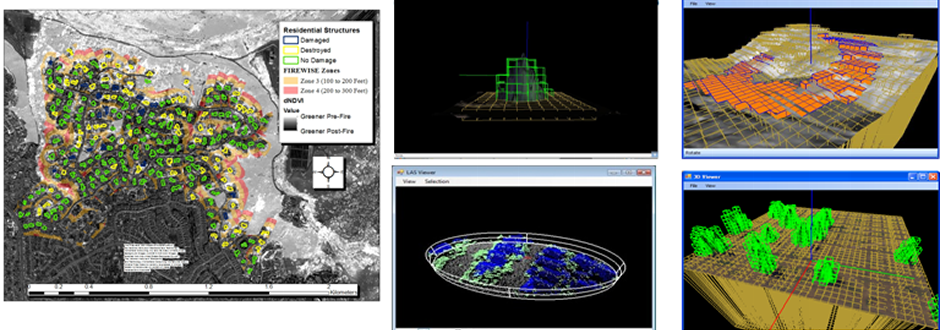
Geospatial Measurement Solutions, LLC: Custom software development; database maintenance and development; remote sensing analysis, data collection, mobile technology implementation, and scientific analysis and documentation.

Remote Sensing in the Wildland-Urban Interface (WUI) (National Institute of Standards and Technology Fire Research Grant 60NANB11D173)
Remote Sensing for Active-Fire Assessment in WUI and Wildland Environments
Web Map Figure 1: MODIS hotspots for past twenty four hours (red dots) overlaid with current fire activity (orange and white fire symbol). Higher resolution mapping of active wildland fire environments can be seen in the Wildfire Airborne Sensor Program (WASP) imagery. Animations presenting imagery acquired with the WASP sensor at the 2012 RxCadre research burns can be seen in the interactive web map figure 2 below. As can be seen through examination of these images fire behavior varied greatly within the area. This highlights the need for integrated measures including pre-fire measures of vegetation. Nonetheless, the WASP data can also be calibrated to provide quantitative fire radiation measurements across a fire. The WASP sensor also provides NADIR views of the scene so distortions due to oblique angles are not an issue. Temporal resolution of the WASP sensor provides repeat coverage but there are delays between acquisitions of the same area that are dependent on the mission specifications as the plane must typically fly outside the burn area to make turns to re-image the area.
Web Map Figure 2: WASP Imagery from 2012 RxCadre prescribed burns. Quantitative fire radiation measures can also be acquired using remote sensing and sensors mounted on booms, at oblique angles from the fire. An example of this type of remote sensing data was also collected at the 2012 RxCadre research burns. A complete data set from RxCadre for potential fire model integration and evaluation was not available on the Untited States Department of Agriculture (USDA) Data Archive for use with this project by 2014. Consequently, the Camp Swift Research Burns were used as a study site for this project due to availablity of data for this area in 2014. Video from helicopters collected with a local government sensor was also used in study of the 2011 Texas Tanglewood Fire (Maranghides and McNamara, 2016). This imagery portrayed fire behavior in vegetation and burning times of structures. The fire behavior recorded with this sensor, however, was only possible after the higher intensity fire behavior had passed, though some relatively high intensity fire behavior was recorded as discussed in Maranghides and McNamara (2016). The helicopter video also only provides qualitative information with no measures of fire radiation. Nonetheless, the fire behavior portrayed in this video as shown in Figure 50 of Maranghides and McNamara did identify changes in fire behavior based on changes in fuels and topographic position relative to predominant wind direction.
|
©2013 Geospatial Measurement Solutions, LLC - 2149 Cascade Ave. Ste. 106A PMB 240 Hood River, OR 97031, USA 541-436-4486 dmgeo@gmsgis.com